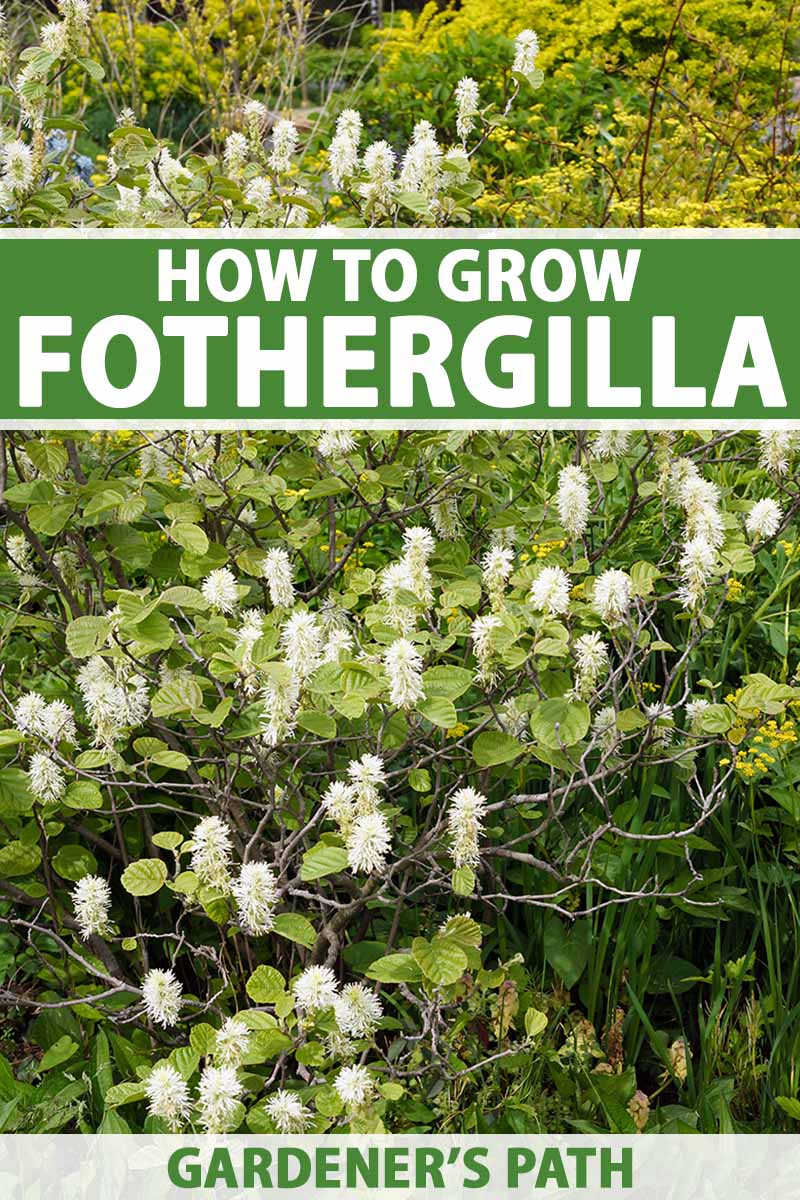Fothergilla spp.
Fothergilla, Fothergilla spp., is a woody shrub in the Hamamelidaceae or witch hazel family suited to cultivation USDA Hardiness Zones 4 to 8.
It blooms in early spring, infusing gardens with a honey-sweet fragrance.
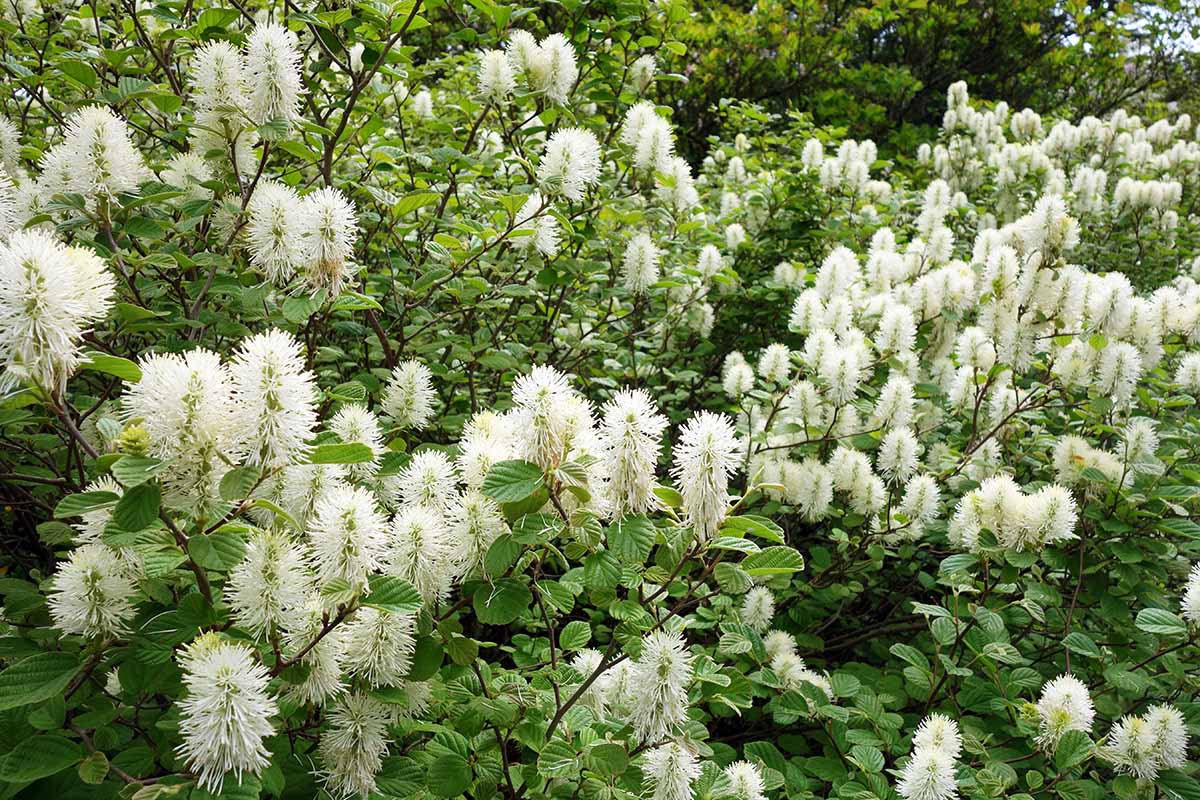

We link to vendors to help you find relevant products. If you buy from one of our links, we may earn a commission.
In the summer, leathery dark green foliage provides a rich backdrop to annuals and perennials.
It lights up the fall landscape with orange, red, purple, and yellow leaves for a spectacular end-of-season display.
Read on for all you need to know to cultivate fothergilla in your outdoor living space.
Here’s what we’ll cover:
Let’s start with a bit of background.
Cultivation and History
Fothergilla is native to the southern United States. It was named for British physician and plant collector John Fothergill, who brought American species to England during the 18th century.
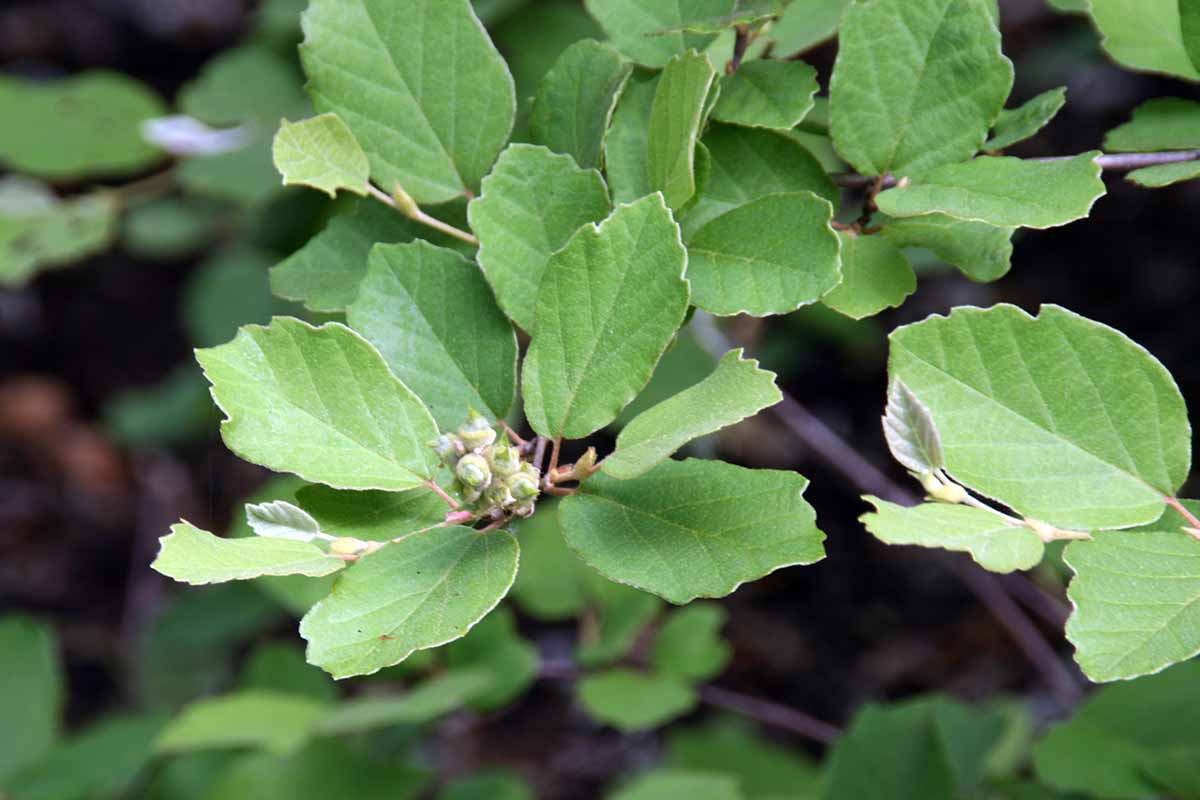

Shrubs have a clumping form with attractively zigzagging branches and dark green to blue-green, leathery foliage with deep ridges.
The shrubs are monoecious, which means they produce both male and female flowers and these are combined in the same inflorescence.
The female flowers are nondescript, while the male blooms are pollinator magnets. They have petal-less, creamy white stamens that resemble bottle brushes with a honey-like fragrance, that bloom for two to three weeks in spring.
Recent research has confirmed four distinct species within the genus:
- F. gardenii, dwarf or coastal fothergilla or witch alder
- F. major, tall or mountain fothergilla or witch alder
- F. milleri, dwarf witch alder
- F. parvifolia, Kearney’s dwarf witch alder
The three dwarf species are so similar that many horticulturists consider them to be variations of F. gardenii and refer to these plants simply as “dwarf” or “large” fothergilla.
F. gardenii and F. major are the two you are most likely to find when shopping for shrubs.
Alabama fothergilla was previously classified as a distinct species, F. monticola, but it is now considered to be F. major.
Dwarf species and cultivated varieties are best suited to Zones 5 to 8. They grow to mature dimensions of 18 to 36 inches tall and 24 to 48 inches wide.
Growth is compact and bushy, the flowers appear before the foliage, and the leaves have symmetrical bases.


Large types grow best in Zones 4 to 8, reaching six to 10 feet tall with a width of five to nine feet.
They have an upright, spreading growth habit, and bloom at the same time the leaves emerge. The leaves are larger than those of the dwarf species, and the bases are asymmetrical.
There are also hybrid varieties classified as Fothergilla x intermedia.


In addition to the species mentioned, fossilized specimens of two US species, F. malloryi and F. praeolata, and others in China and Japan indicate that the Fothergilla genus dates back millions of years.
This suggests an environmental resilience likely responsible for its exemplary pest and disease resistance, and desirability as a commercial and home landscape shrub.
Fothergilla Propagation
There are a couple of ways to propagate your own fothergilla shrubs, including from cuttings and by transplanting nursery starts. Starting from seed is not recommended for home growers.
Let’s take a look at each of these.
From Seed
Fothergilla disperses seeds in a projectile fashion at season’s end.
Collected seeds are difficult to sprout as they require both scarification to weaken the seed coat and cold-stratification to prepare the seed for germination.
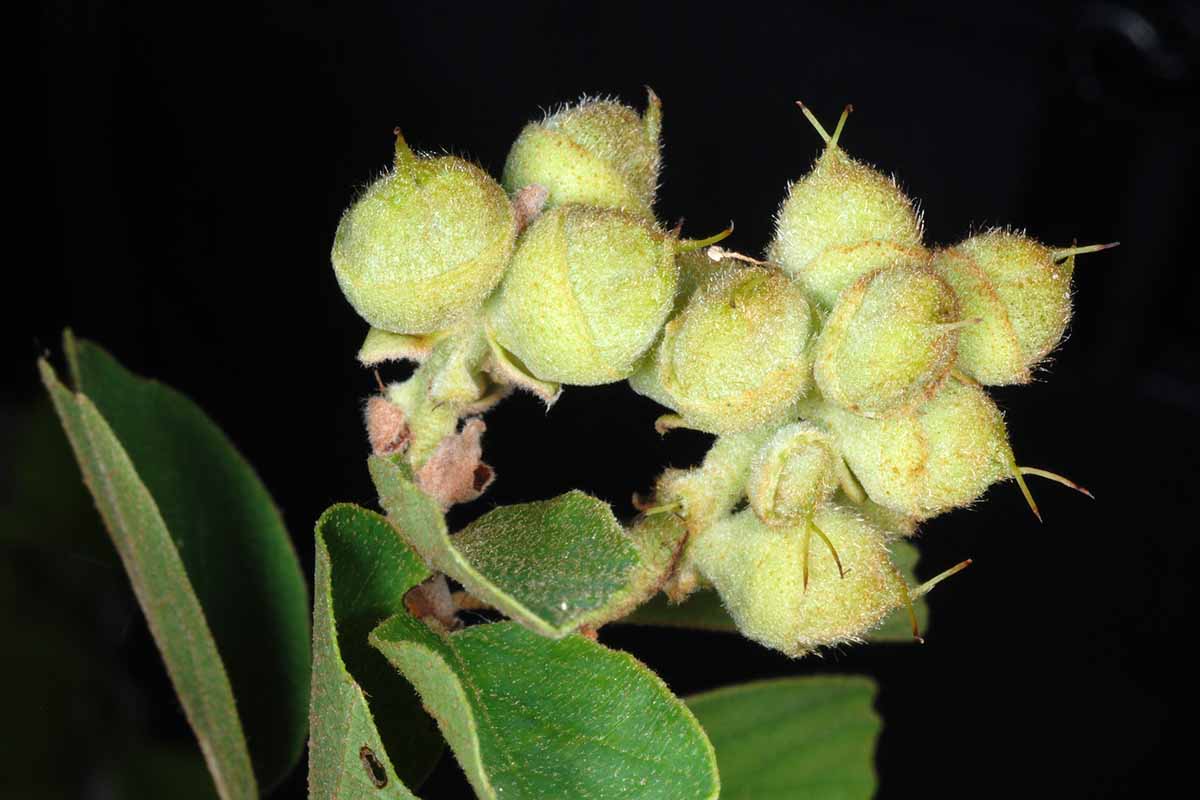

It can take between nine and 15 months for seeds to germinate.
Also, seeds from hybrids and other cultivated varieties may not be viable. If they are, they won’t produce true replicas of the parent plants.
To clone a favorite, take soft stem or sucker cuttings.
From Sucker Cuttings
Suckers are baby plants that emerge from the crown beside the parent in the spring.
Without pruning, suckers create a colony of shrubs, which may be desirable if you’re growing fothergilla for privacy hedging.
To remove a sucker for propagation, choose one that is at least four inches tall.
Use sanitary shears to sever it cleanly at its base, taking care not to damage neighboring plant tissue or leave jagged edges that may invite pests and pathogens.
Recut the stem just below the lowest leaf node, a natural growing point.
Dip the cut end into rooting hormone powder.
Place the stem in a four-inch seed starter pot filled three-quarters full of potting soil at a depth just below the lowest remaining leaf.
If there is tip foliage in addition to the lowest leaf, pinch off the newest growth at the tip.
Put the pot in bright, indirect sunlight and keep the soil evenly moist but not waterlogged.
New leaves signify the successful establishment of roots and readiness for transplant.
From Softwood Stem Cuttings
To take a softwood stem cutting:
Cut a four-inch length of soft, green stem just below a leaf or leaf node. The stem should be long enough that it has several leaf nodes.
Pinch or snip off the lowest leaf and the tip growth, then dip the cut end of the stem into rooting hormone powder.
Insert the dipped stem into a four-inch seed starter pot three-quarters full of potting medium to a depth just below the lowest leaf.
Moisten the soil and keep it evenly moist during establishment. Place the pot in bright, indirect sunlight.
When new growth appears, transplant the cutting to the garden before summer’s end to give it time to establish before the first frost.
Some gardeners also take greenwood cuttings a little later in the summer, but if there isn’t enough time for the cutting to root and grow foliage before first frost, you’ll have to store the pots indoors for the winter and plant them out the following spring.
Transplanting
When transferring a seedling, rooted cutting, or nursery plant to the garden, you need to set it slightly higher than the ground level to facilitate excess water runoff.
To plant, work the soil to a depth of 12 inches and at least twice as wide as the root ball until it is crumbly and free from debris and rocks.
Amend with compost as needed to acidify the growing environment.
Elevate transplants slightly above ground level. This type of mounding sets the crown, where the roots and stems meet, high to ensure the adequate drainage fothergilla requires.
Backfill and tamp down firmly. Water well and tamp again to deflate air pockets.
Keep the new starts evenly moist but not waterlogged until they become established. New foliar growth signifies success.
How to Grow Fothergilla
F. major and F. gardenii prefer full sun to partial shade and organically rich, slightly acidic to neutral soil with a pH of 5.0 to 7.0.
Conduct a soil test as needed to determine the growing conditions in your garden.
Moisture needs are moderate, and once established, these shrubs have above average drought tolerance.
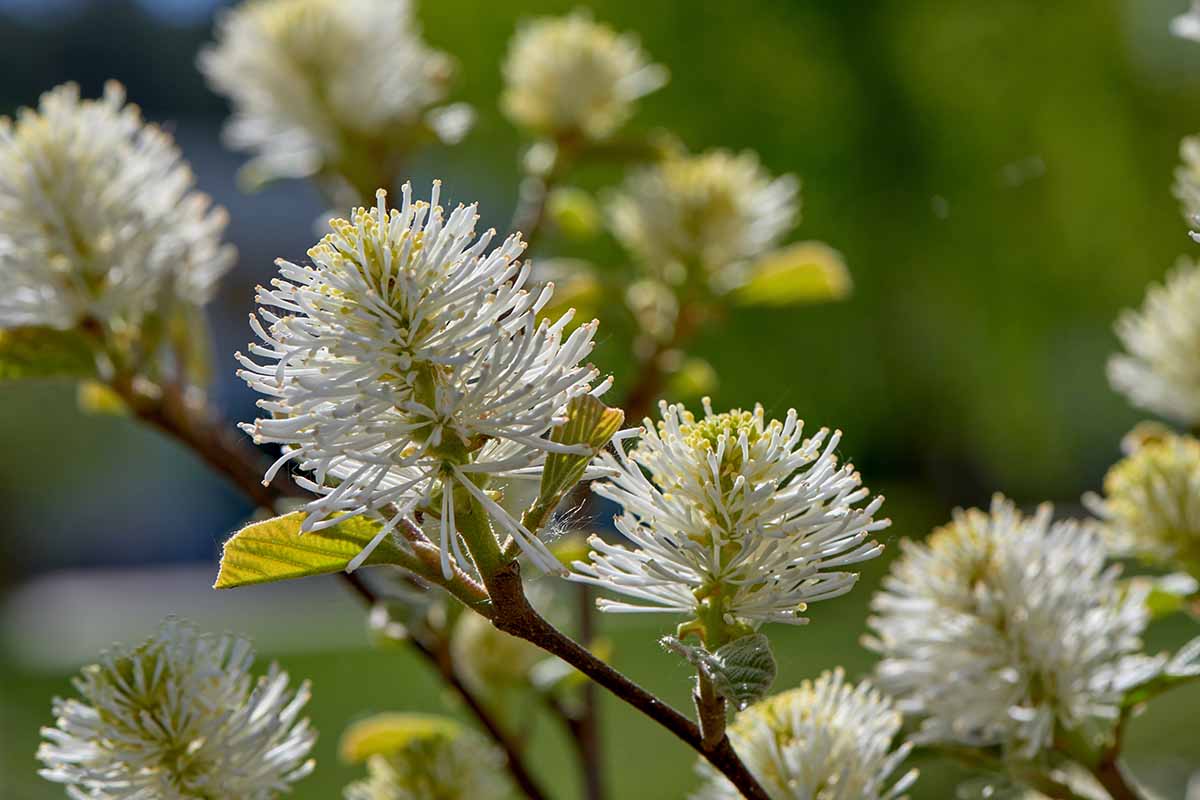

During establishment, maintain even moisture without oversaturation and then supply an inch of water per week in the absence of rain.
If you are growing multiple standalone shrubs, note the expected mature width and allow enough space between specimens to achieve it.
For hedges, closer planting improves density, but the center of each plant should be at least 12 to 24 inches apart to avoid root crowding.
Growing Tips
- Plant in full sun or part shade.
- Grow in organically rich soil with a pH of 5 to 7.
- Provide an inch of water per week.
Pruning and Maintenance
In early spring, remove suckers that grow around the shrubs per the instructions in the propagation section above, unless you want to encourage the shrubs to take on a multi-branch form and colonize the area.
Amend the garden soil with an acidic compost, such as pine bark or shredded leaves, to enrich and acidify it.
Fertilize once or twice in the spring with an acidifier, like Holly-Tone, per package instructions.


Espoma Holly-Tone
Holly Tone has a 4-3-4 NPK (nitrogen, phosphorus, potassium) ratio. It is organic and breaks down naturally, infusing soil with nutrients and acidity.
Holly Tone is available from Espoma via Amazon.
After the flowers finish blooming, prune branches as desired to remove dead material, shape, or shorten. For instructions, see our guide to pruning shrubs and woody plants.
Fothergilla Cultivars to Select
When selecting species and cultivars, consider growing zones, size, summer and fall leaf color, and any highlights noted in plant descriptions.
Here are some options to consider:
Blue Shadow
F. major ‘Blue Shadow’ is a cultivated tall variety with mature dimensions of five to six feet tall and wide.
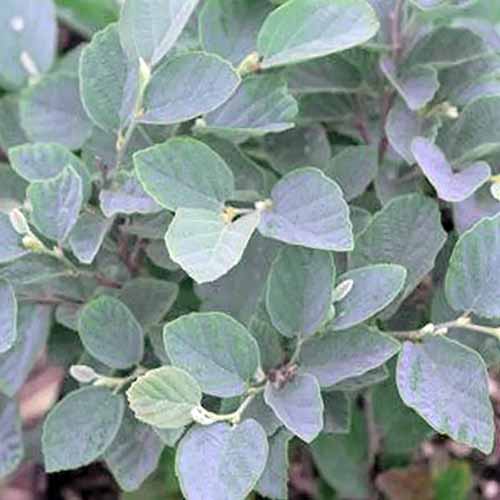

‘Blue Shadow’
The spring and summer foliage is a striking blue-green that shades to orange, red, and yellow in autumn.
F. major ‘Blue Shadow’ is available from Nature Hills Nursery.
Dwarf Fothergilla
Dwarf F. gardenii has dark green foliage, white blossoms, and spectacular fall yellows, reds, and oranges. It grows up to three feet tall and wide.
It is the straight species found in the wilds of the southern United States.


Dwarf Fothergilla
Dwarf F. gardenii is available from DAS Farms via Amazon. Plants are one- to two-feet-tall in one-gallon pots with soilless media for shipping.
Mount Airy
F. major ‘Mount Airy’ is a tall cultivar that prefers full sun and matures to a height of five to six feet with a spread of four to five feet.
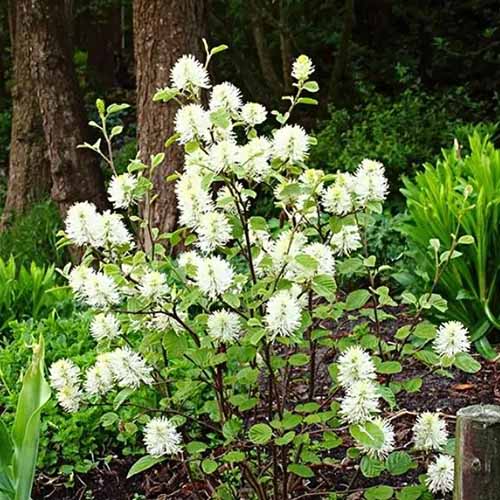

‘Mount Airy’
Its leathery green foliage shades to blue-gray in the summer and bursts into orange, purple, red, and yellow in the fall.
F. major ‘Mount Airy’ is available from Nature Hills Nursery in #3 containers.
Managing Pests and Disease
While not prone to pests or disease, fothergilla may fall victim to either or both if weakened by poor growing conditions, such as an iron deficiency causing chlorotic or yellow leaves.
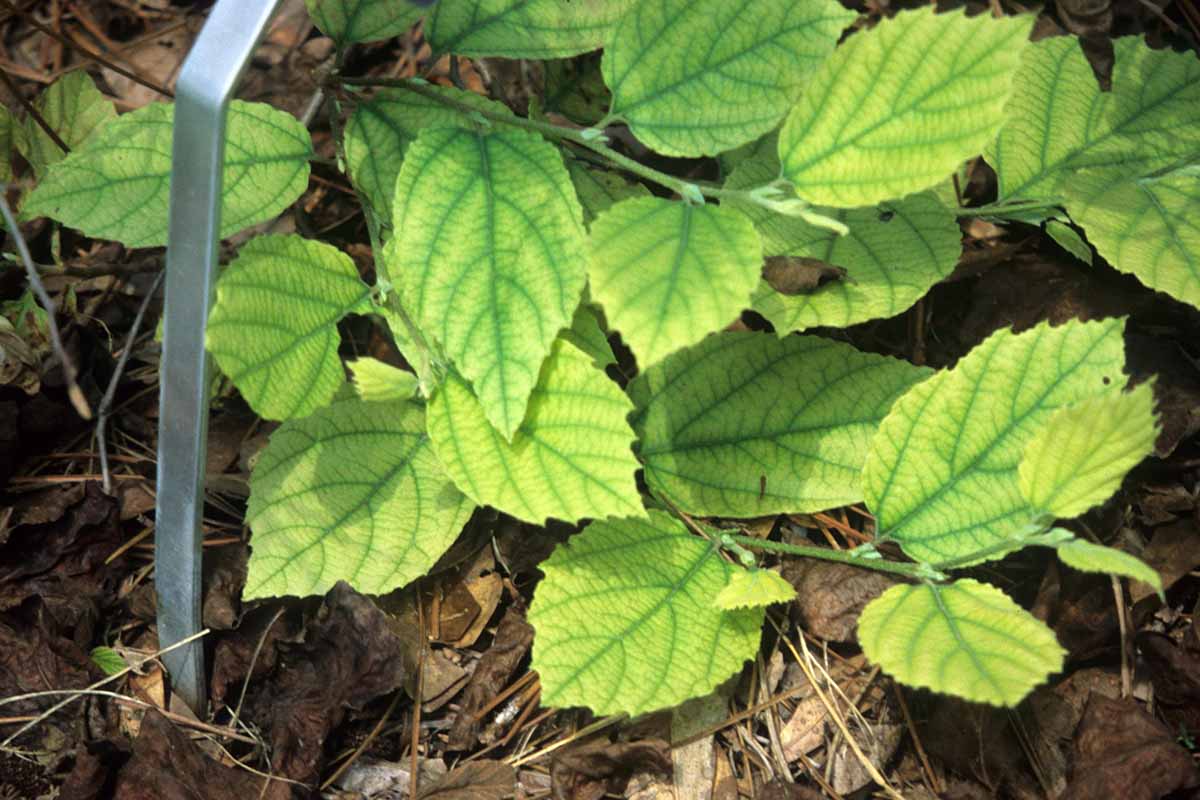

The primary disease of concern is Pseudocercospora leaf spot caused by the fungal pathogen Pseudocercospora fothergillae.
Symptoms include brown spotting, leaf browning, and leaf drop. Environmental stress and oversaturated conditions favor fungal development.
There are no serious pest issues associated with plants in the Fothergilla genus.
Best Uses for Fothergilla
The stature of the shrubs you choose helps determine their best landscape placements.


Tall species and cultivars make excellent privacy hedges, especially if you allow the suckers to remain in place to create density.
Dwarf types are suited to low-profile hedging, foundation placements, mixed shrub groupings, garden beds and borders, and standalone specimen positions.
Quick Reference Growing Guide
| Plant Type: | Woody shrub | Flower/Foliage Color | White / green, blue-green |
| Native to: | North America | Tolerance: | Drought |
| Hardiness (USDA Zone): | 4-8 | Maintenance: | Low |
| Bloom Time/Season: | Spring | Soil Type: | Organically rich |
| Exposure: | Full sun to part shade | Soil pH: | 5.0-7.0 |
| Spacing: | 24-48 inches (dwarf), 5-9 feet (tall) | Soil Drainage: | Well-draining |
| Planting Depth: | Crown slightly above soil level | Attracts: | Pollinators |
| Height: | 18-36 inches (dwarf), 6-10 feet (tall) | Uses: | Bed, border, foundation planting, hedging, mixed group, privacy screen, specimen |
| Spread: | 24-48 inches (dwarf), 5-9 feet (tall) | Order: | Saxifragales |
| Growth Rate: | Slow | Family: | Hamamelidaceae |
| Water Needs: | Moderate | Genus: | Fothergilla |
| Common Pests and Diseases: | No significant pests, Pseudocercospora leaf spot | Species: | Gardenii, major, milleri, parvifolia |
A Four-Season Shrub
Fothergilla is a low-maintenance shrub for full sun to part shade placements with rich, moist, well-draining soil.
In the spring, it wakes gardens up with creamy, honey-scented bottle brush blooms, followed by summer’s richly textured blue to blue-green foliage.
In the autumn sunshine, orange, purple, red, and yellow light up, followed by a winterscape of stark zigzagging branches and the promise of spring’s return.
It’s time to add fothergilla to your garden planner for a shrub that rewards with year-round garden appeal.
Do you grow fothergilla shrubs? Please share your experience in the comments section below.
If you found this growing guide informative and want to read about more spring-flowering shrubs, we recommend the following articles next:


